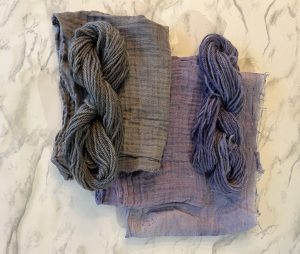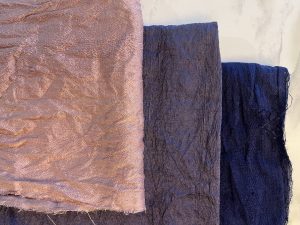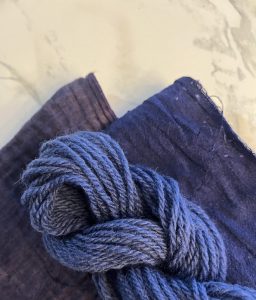
All the images and recipes below should inspire you to try out our newest extract in the shop: sappanwood.
It should also make you think about doing your own experiments with different amounts of extracts and adding iron. How many colors are you missing out on?? Our fabulous Kate Rosendale, who wears many Botanical Colors’ hats just did some experiments using our new sappanwood extract. Look at the beautiful hues above just from using 5% sappanwood extract (calculated as a percentage of the weight of the fiber, or WOF) along with some artful pH shifting and iron! With a pH of 4, Kate got some really beautiful colors. Check out some of the other colors below that she got using different percentages of extract, different pH levels and iron and then without iron as well.
Sappanwood extract is sold in 50g and 100g packages. 100g will dye 1kg of fiber a medium to dark shade with exhaust baths left over.
Here’s what Kate had to say:
- I dyed all of these with the same process – 10 minutes with no heat, gently heating it up for 15 minutes, then holding it at 170-180 degrees for 30 minutes. I didn’t let it get too hot because of the yarn. The color took almost immediately when I started heating it up, though.
- Sappanwood is very pH sensitive so I added Cream of Tartar to lower the pH (make it more acidic) until it registered as pH 4 using pH test indicator strips. Depending on your water quality, you can use 1/2 to 1 teaspoon to shift pH, but it could take more. You can also experiment with vinegar or lemon juice and see what results you get.
- Shifting the pH just a little lower didn’t have much of a result – it took a dramatic pH shift (like from 7 down to 4) to get some of those rosier colors, and even those were only with the 10% WOF on the fabric.
- The higher pH made the tone cooler and more blue almost immediately. Those colors with the pH 10 are really lovely in person! I shifted pH by adding dissolved Soda Ash to the dye bath. Be aware that wool and silk are damaged by long exposure to high pH, so remove the fibers and rinse them after dyeing.
- The overdyed yarn was my favorite result which is why there are so many glamour shots of it! These were skeins that Kathy painted during a demo for her online yarn painting workshop with Sweet Georgia Yarns.
- The cotton bandanas were the worst at taking up the dye – I think some weren’t mordanted, but even the ones that were were not nearly as even as everything else.
- Seattle tap water pH is somewhat acidic – around 6 to 6.5 so we add soda ash to raise the pH to 7.
5% sappanwood extract to WOF, pH 7. The dark shades on the left side went in a post-dye bath with 2% WOF iron. At pH 7, the fibers are a rosy lilac shade. Iron shifts the color deep purple.
5% sappanwood extract to WOF, pH 10. At a higher pH, the color begins to cool and become more purple.
5% of sappanwood extract to WOF, pH 10. The gray shades on the left side went in a post-dye bath with 2% WOF iron.
10% sappanwood extract to WOF with (from left to right) pH 3, pH 7, and pH 10. The very low pH shows the pinkest shades and the very high pH shows the blue-purple shades.
10% sappanwood extract to WOF, pH 3. This was a skein of yarn that Kathy had painted with orange and red shades prior to going into the sappanwood dye. It came out a gorgeous purple with hints of rose and burgundy throughout it.
10% sappanwood extract to WOF, pH 3. The charcoal sample on the left side went in a post-dye bath with 2% WOF iron.
10% sappanwood extract to WOF, pH 3. Notice how the wool and the silk (on the right) pull out a more vivid hue than the cotton gauze sample on the left.
10% sappanwood extract to WOF, pH 10. This is super beautiful as both wool and silk start to take on blue tones, but the cotton remains a grayish purple.
10% sappanwood extract to WOF, pH 10. At a higher pH, the samples shift from purple to blue.
10% sappanwood extract to WOF, pH 10. The dark shades on the right went in a post-dye bath with 2% WOF iron.











Hello, I was very surprised to see such beautiful, rich purple and blue colors from sappanwood. In Indonesia it is used to dye red colors but I had never seen blues or purples. A very interesting blog.
I was also very surprised. This particular extract is blended with some gallnut tannin, which does create a gray-purple with the addition of iron, but the blue-gray shade was unexpected and delightful. We are going to do more experiments and if anything interesting comes out of it, will publish more results. Thanks so much for your comment! Kathy